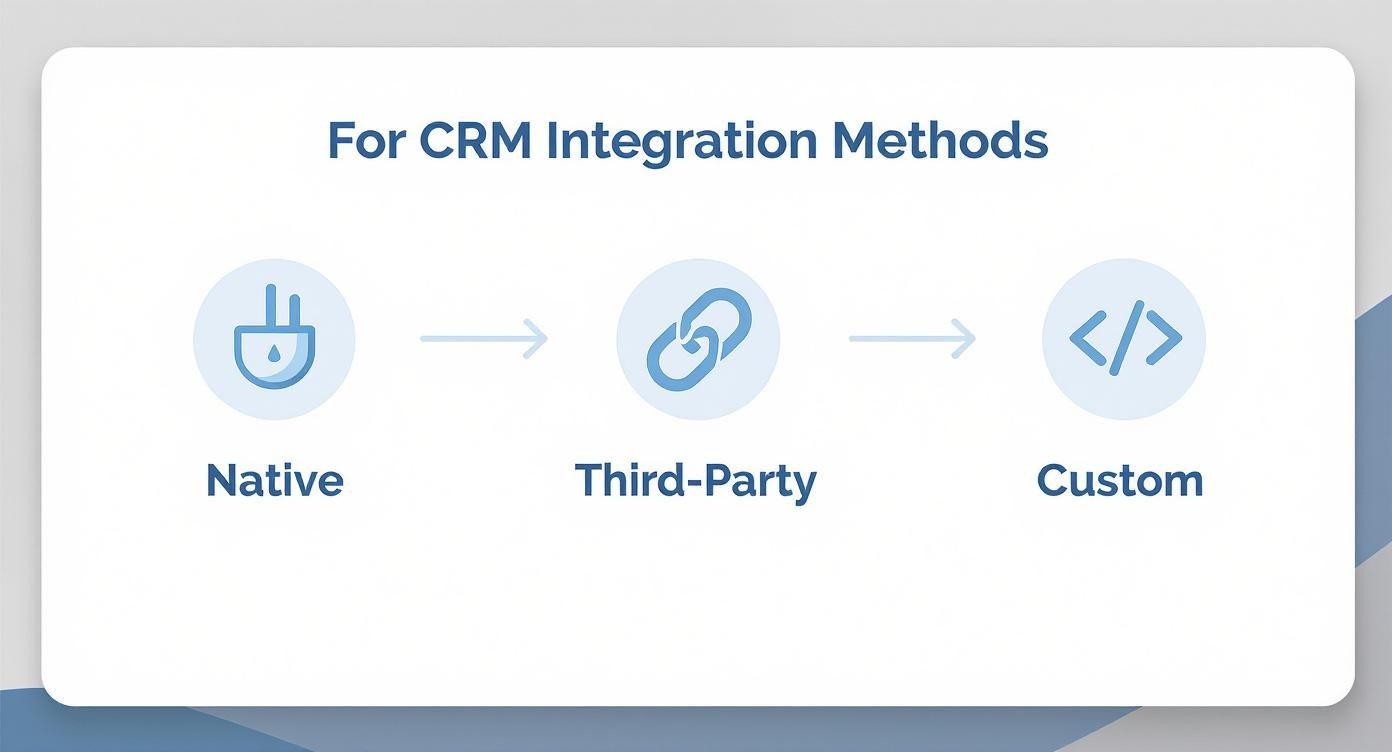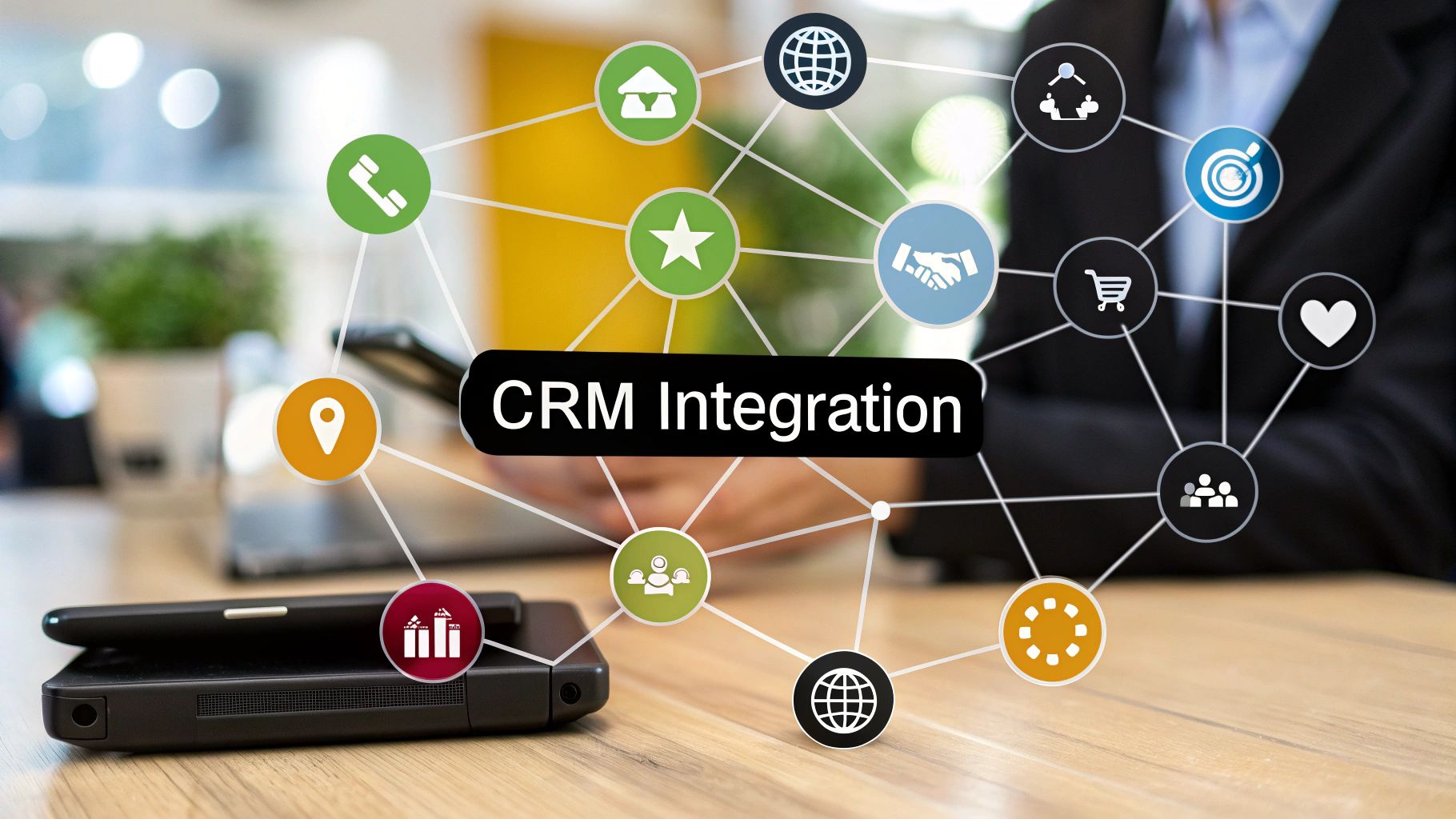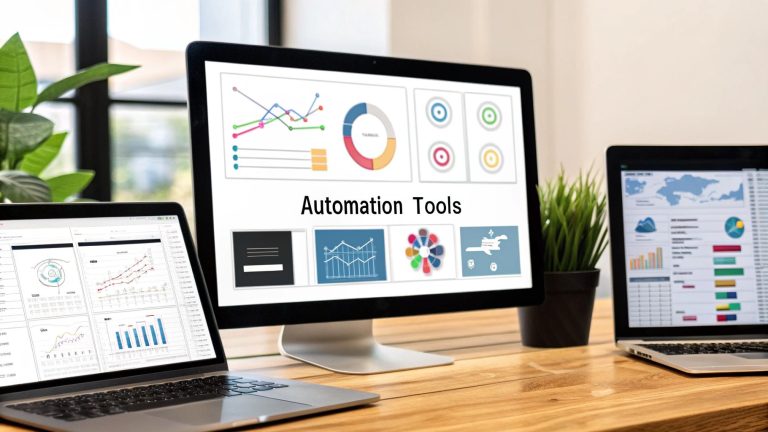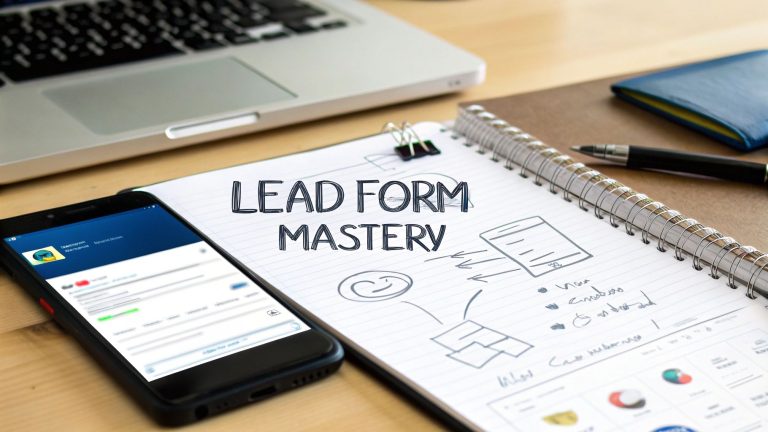what is crm integration? A quick, compelling explainer
So, what exactly is CRM integration?
At its core, it's the process of connecting your customer relationship management (CRM) software to all the other tools your business relies on every day. Think of it as building digital bridges between your sales, marketing, and support platforms so they can finally talk to each other.
This connection creates a single, central hub where all your customer data flows automatically. No more manual data entry. No more guesswork. Just one unified, up-to-date view of every customer interaction.
Getting to Grips with CRM Integration

Picture your business for a second. You probably have a tool for sales, another for marketing emails, and a separate system for customer support tickets. Without integration, each one operates on its own isolated island.
This means your marketing team could be busy sending promos to a lead who, just yesterday, filed a frustrated support ticket. Or your sales reps might be completely in the dark about a prospect’s recent activity on your website. It's a recipe for inefficient work and a clunky, disjointed experience for your customers.
CRM integration is the fix. It acts like the central nervous system for your tech stack, letting crucial information—contact details, email history, support tickets, purchase records—flow freely between every connected platform in real-time. This simple change ensures every single department is working from the same playbook, with the same complete customer profile in front of them.
The Real-World Impact of a Unified System
The difference between a fragmented setup and an integrated one is night and day. Forget manually copy-pasting contact info from your email into your CRM. Forget exporting spreadsheets from your e-commerce store just to see who bought what. With integration, that information just syncs.
This automatic syncing is the engine that powers everything. If you're curious about the mechanics behind it, our guide explains what is data synchronization and why it's so vital for making integrations work.
This seamless flow of information completely changes how your teams operate.
A well-integrated CRM turns scattered, outdated, and inconsistent data into your most valuable asset. It creates the single source of truth you need to make smarter decisions and build genuinely strong customer relationships.
This table really drives home just how much things change.
Business Operations Before vs After CRM Integration
Here’s a clear breakdown of how key business functions get a massive upgrade once you connect your systems.
| Business Function | Before Integration (Data Silos) | After Integration (Unified System) |
|---|---|---|
| Lead Management | Sales reps spend their days manually entering lead info from web forms and emails. | New leads from the website automatically pop up in the CRM, ready for follow-up. |
| Customer Support | Agents waste time toggling between the CRM and support software just to find a customer's history. | A complete customer history appears directly inside every support ticket. Problem solved. |
| Marketing Campaigns | Marketing sends campaigns using outdated contact lists, often messaging the wrong people. | Campaigns are precisely targeted using real-time customer data pulled straight from sales and support. |
| Reporting | Teams burn hours trying to merge messy spreadsheets to get a complete picture of performance. | Unified dashboards give you instant, accurate business insights with just a click. |
As you can see, the shift isn't just about convenience—it's about making every part of your business smarter, faster, and more effective.
Why Disconnected Systems Hurt Your Business

When your business tools don't talk to each other, they create invisible walls between your teams. These data silos aren't just a tech headache—they create real friction that your customers can feel and your bottom line will absolutely reflect.
Imagine this: a sales rep, ready to close a big deal, calls a high-value lead. What they don't know is that the lead just spent an hour on a frustrating call with customer support. The sales call is awkward at best and a complete disaster at worst. This is the reality of disconnected systems. It's a world of missed cues, bad timing, and a choppy customer experience.
Each department ends up holding a different piece of the customer puzzle, with no way to see the complete picture. This breakdown doesn't just slow you down; it directly hurts your ability to keep and grow your customer base.
The High Cost of Fragmented Data
Fragmented data isn't just inefficient—it's expensive. When your teams are flying blind with incomplete information, they're wasting time, money, and golden opportunities.
Here’s where it really hurts:
- Wasted Marketing Spend: Your marketing team might be busy targeting customers with ads for products they already own or, even worse, have complained about. That's a surefire way to get low conversion rates and annoy people.
- Lost Sales Opportunities: A sales rep without the full story—like recent support tickets or marketing engagement—can't tailor their pitch. They're just guessing, and guessing doesn't close deals.
- Poor Customer Service: When a support agent can't see a customer's purchase history or past conversations, they can't provide fast, effective help. This leads directly to frustration and higher churn.
When every interaction feels like the first one, you aren't building a relationship; you're just processing transactions. Disconnected data forces your customers to tell their story over and over, chipping away at their trust with every new call or email.
This is a massive problem, and businesses are throwing money at it. The global CRM software market is set to hit $298.61 billion in a single year. That's a clear signal that companies are scrambling to get a unified view of their customers. With 91% of businesses with over 11 employees already using a CRM, the pressure is on to make these powerful systems work together. You can discover more insights on the rapid growth of the CRM software market and see why integration is at the heart of it all.
The Strategic Need for a Single Source of Truth
At the end of the day, the real problem with disconnected systems is the lack of a single source of truth. Without it, your business is running on guesswork and assumptions instead of clear, unified data.
This puts you at a huge strategic disadvantage. It makes it impossible to deliver the kind of smooth, personalized experience that customers now expect. Understanding what CRM integration is is the first step, but seeing the damage that a lack of it causes is what really pushes businesses to change. This isn't just a technical fix; it's a fundamental shift toward building a smarter, more customer-focused company that's ready for real growth.
The Real Benefits of an Integrated CRM

Let's get one thing straight: connecting your systems isn't just a fancy tech upgrade. It’s a strategic move that delivers real, measurable results. A properly integrated CRM is more than a convenience—it fundamentally changes how your business runs, paving the way for serious gains in efficiency, customer happiness, and, of course, revenue.
The biggest win right off the bat? Creating a single source of truth. This kills the guesswork and costly mistakes that come from juggling outdated spreadsheets and manual data entry. When every department—from sales to support—sees the exact same complete customer profile, decisions get made faster and with far more confidence.
Boost Operational Efficiency
If there's one thing that drains any team's energy, it's repetitive, manual work. CRM integration is the antidote, automating the flow of information between your tools and erasing those mind-numbing tasks from your team's to-do list.
Think about it. With an e-commerce integration, a new purchase can automatically update a customer’s CRM profile, trigger a personalized "thank you" email from your marketing tool, and create a follow-up task for a sales rep. That's a seamless workflow that frees up your people to do what they do best: build relationships and close deals, not copy and paste data all day.
This kind of automation is a huge driver of business value. It's no surprise that large enterprises, which account for a massive 73.8% of global CRM spending, are laser-focused on sophisticated integrations to manage their complex data streams. The heavy emphasis on these connected systems, especially in mature markets like the United States, shows just how vital this strategy is for growth. You can explore more market data on CRM integration trends to get the full picture.
Deliver Superior Customer Experiences
A complete, unified view of the customer gives every team the power to deliver amazing, personalized service. When a support agent can instantly see a customer's entire purchase history and every past conversation, they can solve problems faster and with the right context.
An integrated CRM ensures that no matter who the customer talks to—sales, marketing, or support—they get a consistent and intelligent experience. This builds trust and turns one-time buyers into loyal fans.
This is exactly what modern customers expect. They don't see your business as a collection of separate departments; they see one brand. An integrated system helps you meet that expectation effortlessly, making every single interaction feel personal and informed.
Enable Smarter Business Decisions
Finally, unified data means dramatically better reporting and forecasting. When all your customer information lives in one central hub, you can generate accurate, comprehensive reports with just a few clicks. This lets you:
- Track the entire customer journey, from the very first marketing touchpoint to the final sale and beyond.
- Pinpoint your most profitable channels and campaigns with clear, undeniable data.
- Forecast future sales with a much higher degree of confidence and precision.
By breaking down those frustrating data silos, you gain the clarity you need to make smart, data-driven decisions that steer your entire business in the right direction.
Popular Types of CRM Integrations
Once you realize just how powerful a connected system can be, the next question is obvious: what should you connect first?
Not every integration brings the same value to every business. The real secret is to focus on the connections that solve your biggest headaches and give you the most immediate bang for your buck. Think of these integrations as specialized apps for your company's main operating system—each one built to make a specific job, like managing emails or tracking sales, a whole lot easier.
Email and Calendar Integration
This is the bread and butter for any sales or service team. Connecting your CRM to tools you already live in, like Gmail or Outlook, is a non-negotiable first step. It gets rid of the soul-crushing task of logging every single conversation by hand.
- Automatic Logging: Every email sent and every meeting booked with a client gets saved to their contact record in the CRM. No more copy-pasting.
- Complete History: A sales rep can see the entire history of communication right before jumping on a call, so they always know exactly what's going on.
- Streamlined Scheduling: You can book meetings right from the CRM, and your calendar availability syncs in real-time.
This simple connection transforms your chaotic inbox into a powerful, organized part of your customer database.
Marketing Automation and Social Media Integration
For your marketing crew, plugging platforms like HubSpot or Marketo into your CRM is a total game-changer. This integration creates a smooth-flowing river of data between marketing campaigns and sales follow-ups.
When a potential customer clicks on an ad or downloads a guide, that activity instantly shows up in the CRM. This gives your sales team priceless context. Social media is another goldmine here. For instance, a smart CRM integration with Facebook can automatically pull leads from your ad campaigns and drop them right into your sales pipeline. It closes the loop between a "like" and actual revenue.
This integration finally builds the bridge over the classic gap between sales and marketing. It helps marketing deliver hot, informed leads and gives sales the full story they need to close the deal.
E-commerce and Customer Support Tools
If you're running an online store, an e-commerce integration with a platform like Shopify or Magento is an absolute must. This link syncs everything—purchase history, order status, and even abandoned cart info—straight to a customer's profile. All that rich data lets you create highly personalized marketing and proactive customer service.
It's the same story for customer support. Integrating tools like Zendesk or Intercom gives your agents superpowers. When a customer sends in a ticket, the agent immediately sees their entire history in one place: past purchases, previous support chats, and recent interactions.
Want a specific example of this in action? A chatbot for Salesforce integration is a perfect showcase of how AI can supercharge one of the world's leading CRMs.
The market for this stuff is enormous. In the U.S. alone, CRM system providers pulled in an estimated $45.3 billion in revenue in a recent year, all because businesses are scrambling to connect these different customer touchpoints. This massive growth just goes to show how essential these connections have become to stay competitive. (Learn more about the CRM provider market size and its leaders).
Comparing Popular CRM Integration Types
To help you visualize where to start, here's a quick breakdown of the most common integration types and the value they bring to the table.
| Integration Type | What It Connects | Primary Business Benefit |
|---|---|---|
| Email & Calendar | CRM with inboxes (Gmail, Outlook) | Boosts sales productivity by automating data entry and simplifying scheduling. |
| Marketing Automation | CRM with platforms (HubSpot, Marketo) | Aligns sales and marketing by creating a seamless lead-to-customer journey. |
| Social Media | CRM with social channels (Facebook, LinkedIn) | Captures leads directly from social ads and tracks customer engagement. |
| E-commerce | CRM with storefronts (Shopify, Magento) | Creates a 360-degree customer view with purchase history and behavior. |
| Customer Support | CRM with helpdesks (Zendesk, Intercom) | Empowers agents with full customer context for faster, better service. |
| ERP & Finance | CRM with accounting tools (QuickBooks, NetSuite) | Unifies financial data with customer data for accurate forecasting and billing. |
Each of these connections is designed to eliminate a specific silo in your business, bringing you one step closer to a single, unified view of your customer.
How to Approach Your CRM Integration Strategy
Once you see the benefits, the next question is always the same: how do you actually connect all your systems? Picking the right CRM integration strategy isn't about being a tech wizard. It’s about matching the right tool to your business needs, budget, and the resources you have on hand.
Think of it like getting power to a new appliance. You’ve got a few options, and each comes with its own pros and cons. Let's walk through the three main paths so you can have a smart conversation with your team or any partners you bring in.
Start with Native Integrations
The simplest and often best place to start is with native integrations. These are basically pre-built connectors offered directly by your software vendors. Imagine buying a new phone and finding it has a perfect, official adapter for your car—it’s designed to just work, right out of the box.
You’ll usually find these in a platform's "app marketplace," and turning them on often takes just a few clicks. They are perfect for connecting popular, mainstream tools because the developers have already done all the heavy lifting for you.
- Best For: Connecting major software like your CRM to Gmail, Outlook, or Mailchimp.
- Key Advantage: They are generally reliable, secure, and fully supported by the software company itself.
Explore Third-Party Platforms
Next up, we have third-party integration platforms, which you might hear called iPaaS (Integration Platform as a Service). Tools like Zapier, Make, or MuleSoft act like universal travel adapters for all your software. They aren't made by your CRM provider, but they specialize in one thing: connecting thousands of different apps.
These platforms are incredibly flexible, letting you build custom "if this, then that" workflows between almost any two systems you can think of. This is a super powerful way to automate tasks without needing a developer on standby. To get a better sense of how this works, check out our guide on what is an automated workflow and see how these connections drive business efficiency.
Think of iPaaS as the ultimate middleman. It listens for a trigger in one app (like a new sale in Shopify) and automatically performs an action in another (like creating a new contact in your CRM).
Consider Custom API Integrations
Finally, there’s the big one: a custom API integration. An API (Application Programming Interface) is just a set of rules that lets different software programs talk to each other. Building a custom integration is like hiring an electrician to design and install a bespoke power solution just for your unique setup.
This path gives you the most power and flexibility, but it’s also the most demanding. It requires skilled developers and ongoing maintenance to keep it running smoothly. It's the right choice only when you have very specific needs that an off-the-shelf solution just can't handle.
- Best For: Unique business processes, proprietary software, or complex data mapping needs.
- Key Disadvantage: Higher upfront cost, longer development time, and you'll need technical experts to manage it.
Building Your CRM Integration Roadmap
Jumping into a CRM integration can feel like a massive undertaking. It’s easy to get overwhelmed. But with a clear plan, you can turn a daunting project into a strategic win for your business.
The secret? It’s not about the fancy tech you choose. A successful integration is built on a solid strategy that’s laser-focused on your business goals, not just powerful software.
Charting Your Course
Your first step is to look inward. Before you connect a single thing, you need to define your business objectives. What are you really trying to accomplish? Are you looking to shorten your sales cycle? Boost customer retention? Squeeze more ROI out of your marketing spend?
Pinpointing your primary goal is everything. It dictates which integrations will give you the most bang for your buck right out of the gate.
From there, it's time to map out your current data flows. This helps you find the biggest friction points in your daily operations. Where are your teams burning hours on manual data entry? Where do communication breakdowns happen most often? Hitting these high-pain areas first will score you a quick, impactful win that gets everyone on board.
Don’t try to boil the ocean. The key to building momentum is to start small. Focus on one or two high-impact integrations that solve an immediate, tangible problem. A great example is connecting your email to your CRM—it's a simple move that can instantly make your sales team more productive.
This visual breaks down the three main ways to connect your systems, from simple plug-and-play options to more complex custom builds.

As you can see, the path is progressive. You can start with simple native connections and then move on to more advanced methods as your business grows and your needs change.
Make sure you involve people from every department that will be affected—sales, marketing, customer support, you name it. Their real-world insights are gold. They'll help you spot challenges you might have missed and ensure the final setup actually works for the people using it every single day.
Finally, treat data security as a non-negotiable from day one. A great CRM integration puts your most valuable asset—your customer data—all in one place. Its security can't be an afterthought; it has to be a core part of your roadmap from the very beginning.
Got Questions About CRM Integration? We've Got Answers
Even with a solid plan, a few questions always pop up when you get down to the details. Let's tackle some of the most common ones I hear from businesses just starting their integration journey.
How Do I Pick the Right Integration Tools?
If you're running a small business, my advice is always to start simple. The best place to look first is for native integrations. Think of these as the "plug-and-play" connections built right into your software's app store or marketplace.
They're reliable, fully supported, and you can usually switch them on with just a few clicks. It's the perfect, no-fuss way to link up essential tools like your email marketing platform without needing a developer on standby.
But what if there's no native option? Your next best friend is a third-party tool like Zapier. These platforms are brilliant because they act as a universal translator, connecting thousands of different apps. They give you incredible flexibility without the hefty price tag of a custom-built solution.
What's the Difference Between a One-Way and a Two-Way Sync?
Getting this right is absolutely crucial. The direction of the "sync" determines how your data talks between systems, and it makes all the difference.
-
One-Way Sync: This is a simple data push. A new lead fills out your website form, and that information gets pushed into your CRM. That's it. The data only ever travels in one direction, from A to B.
-
Two-Way Sync: Now this is where the magic happens. A two-way sync creates a mirrored connection. You update a customer's phone number in your CRM, and poof—it's instantly updated in your email marketing tool. They update their details via an email link? It flows right back into the CRM. This keeps everything consistent, everywhere, all the time.
A two-way sync is what turns your CRM into a true single source of truth. It kills data discrepancies and ensures every single person on your team is working with the most current information, no matter which app they have open.
How Much Is This Going to Cost Me?
Integration costs can be all over the map, but it's not as scary as it sounds.
Native integrations are often baked into your software subscription, so they're effectively free. Third-party platforms like Zapier typically have free plans for simple workflows, with paid plans climbing from $20 to a few hundred dollars per month, depending on how many tasks you're running.
Custom API integrations are the big-ticket item. You're paying for a developer's time, which can run into the thousands, plus you'll have ongoing costs for maintenance. Honestly, for most small and mid-sized businesses, sticking with native and third-party tools gives you the best bang for your buck.
How Do I Know If It's Actually Working? (Measuring ROI)
You can't just "feel" if an integration is working; you have to measure it. The best way to track your return on investment (ROI) is to look at a few key business numbers before and after you flip the switch.
Here’s what you should be tracking:
- Time Saved: Literally calculate the hours your team gets back from not having to do manual data entry. Multiply those hours by their wage. That's real money.
- Sales Productivity: Are your reps closing deals faster? Are they handling more leads without getting overwhelmed?
- Customer Retention: A better customer experience should mean fewer people leaving. Keep an eye on your churn rate.
- Fewer Screw-Ups: Track how often data entry mistakes were causing problems (like sending an invoice to the wrong address). A drop in those errors is a huge win.
When you focus on concrete numbers like these, you can easily prove the financial value your CRM integration is bringing to the table.
Stop wasting time manually downloading leads from Facebook. LeadSavvy Pro automates the entire process, sending new leads directly to your Google Sheet or CRM in real-time. Start your free plan today and see how easy it is to capture and convert leads faster. Learn more at https://leadsavvy.pro.







